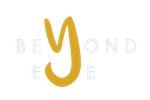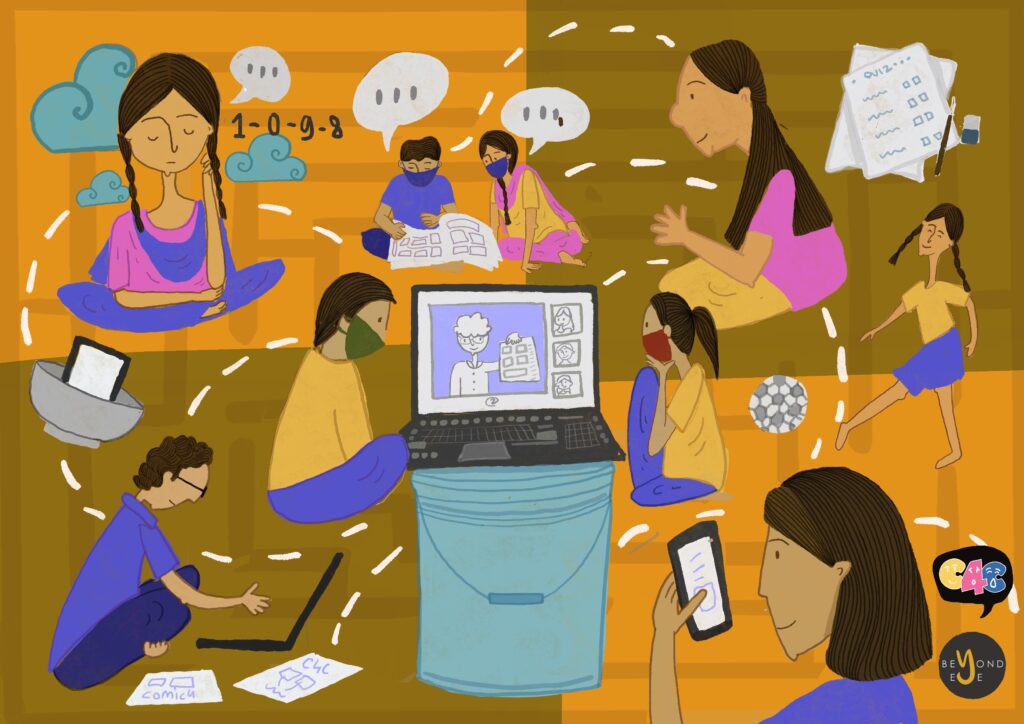As a part of the Youth Champions Initiative (YCI) -2019, the Comics For Change project (C4C) was developed to work with adolescents by YCI fellow, Jitender. The project focussed on creating age-appropriate comprehensive sexuality education visual tools for adolescents to facilitate dialogue on issues such as menstruation, child sexual abuse, bullying, and violence. Many of these conversations also include discussions on body, feelings, sexuality, growing up, adulting, puberty, and many more; an approach that requires a comprehensive lense to understand adolescents and many questions that get formed. Conducting these sessions amidst a pandemic was even more difficult. It required adapting to the new circumstances while ensuring the conversations were impactful. Additionally, the team also worked around the ever so evident digital divide. These are unprecedented times, but that helped us learn new ways to work together with the adolescents on these issues.
It is often quite difficult to engage with adolescents on issues like
these which are considered a taboo in society, and be able to provide holistic
information while ensuring they feel safe. Using visual tools supports these
conversations and provides adolescents a space to share their thoughts and
feelings freely. YCI fellow Jitender
with their team aimed at using human centered design in this project to ensure
maximum participation from the adolescents. A human centered design approach
placed adolescents at the centre of the entire initiative with not only co-developing visual tools for them
but with them. As a result, the adolescents adopted the role of our
collaborators and supported us in developing age-appropriate CSE visual tools.
Initially, the project was piloted in the rural areas of Uttarakhand and
Rajasthan in 2018. Later, as part of the YCI fellowship – 2019, the project was
successful in gaining a government school partnership in urban locations of
Delhi. However, owing to the Covid-19 pandemic, and closure of educational
institutes in March 2020, the implementation could not move forward. It took
the project team some time to work around new upcoming challenges that came
with working in a global pandemic. By September 2020, the team was able to
adapt, and build new partnerships to bring these pertinent conversations to
adolescents virtually using technologies like Zoom. We were able to connect
with organizations like Teach For India, Khushii Organization, and The
Community Library Project. Additionally, there were also adolescents who joined
us from areas like Nehru Nagar and Palam Vihar in Delhi.
Conducting online Zoom sessions was a different experience for us, and a part
of accepting a new normal in a Covid-19 world. Some of the issues were around
digital divide, attention span of adolescents on online platforms, safe spaces
to have open discussion, and general anxiety of a world filled with
uncertainties. The Comics for Change Project team decided to develop new online
games, quizzes, and various tools to deal with such situations. This resulted
in development of online maze games, quizzes, pictionary picture matching
games, story videos etc. These additions
became an integral part of the project to make Zoom sessions more fun and
interactive for the adolescents.
Some of the other limitations while implementing our work was around language.
We wanted to ensure that we had the adolescents’ complete attention, so we
stayed away from introducing anything too complicated or using complex language
since that could have potentially taken away their attention. Our team also
conducted the sessions primarily in Hindi. While the groups did have some
adolescents who could understand English, there were also some who found it
difficult to read and write Hindi. This also had an impact on our session designs.
The aim was always to design a session that was accessible to all the
participants, and ensured their attentiveness.
One of the major challenge for the team was working around triggers
related to sexual abuse. It was reported that Indian child helpline, 1098, had
seen a sudden rise of distress calls from adolescents facing physical and sexual abuse at home
during the lockdown. Violence and child sexual abuse had an adverse impact on
adolescents, especially with the pandemic in full force. Since the sessions
were conducted digitally and due to our inability to support mental health
counselling at the time, it was difficult to ensure the participants’ mental
well-being and safety. The risks are higher in an online session is what we
realized, so our team actively worked to limit any triggers. Sometimes, this
also led to censoring some issues we’d originally would have discussed in an on
ground setting. Despite this, we did create sessions designs around building
comfort among adolescents. We attempted to introduce various feasible coping
mechanisms in case of such incidents. For example, it was deemed important to
ensure that adolescents are aware that they can speak to even their friends if
they are facing any such issues. It was done to normalize and internalize the
idea that such incidents are not their faults.
Using Zoom as a platform for these sessions brought about a lot of new learning. We learned that doing workshops online requires different things to keep in mind. One of these factors is having a time limit. With sessions on ground, one would have the luxury to take frequent breaks, have more ice-breakers, and have better interaction. But on an online platform, one does not have this luxury. The adolescents were already involved in their online classes, and many of the households had limited technological access. As a result, keeping them engaged for the duration was difficult. We made sure our sessions weren’t crossing over 90 minutes. However, we did struggle in keeping the adolescents completely engaged for an hour as they often had to drop off because of classes, connectivity issues or because they were feeling tired.
Another large reason for adolescents having limited time and contributing to the limitations of the C4C implementation work, was lack of access to technology. The Covid-19 pandemic clearly showed the reality of the Digital Divide in India. None of the participants in the Comics for Change sessions had access to laptops. Most of them were attending sessions via a smartphone given to them by their families. In fact, some of the adolescents came from families where there was only one smartphone shared by everyone. And, they had to drop out of meetings when their parents needed their phones to go out for work.
In current times, the digital divide is clearer than ever. It portrays the class division among various people, and shows how so many people have been left behind in a world that is slowly becoming exponentially digital without creating spaces or providing access to those who are unable to afford a digital life.
Keeping all these limitations in mind, we worked around these issues to ensure interactive online sessions for all our participants. The digital divide brought about a lot of learning for us, and we modified our sessions based on what the participants needed.
For instance, we learned that follow along instructions should be avoided during a live session as there are a lot of connectivity issues and one often takes up additional time to repeat the instructions. Instead, we shared an instructional video in advance and repeated the instructions once again. We experimented this with the two groups we were working with on an activity to make an 8-page zine. With the first group, we gave the instructions on the call and asked them to follow along. This was quite a chaotic experience. Whereas with the second video, we shared the instructional video in advance and repeated them in the live session. The activity was conducted a lot smoother and participants were able to do the required steps as well since they had more clarity. Adolescents ended up making many zines and narrative on the issues that we were working with them.
Working with adolescents during an ongoing pandemic was difficult, but definitely had its own share of learnings and experiences. For instance, a member from our team was using a mobile to facilitate sessions at home where the girls in her area would gather. Since they didn’t have a speaker, the team member ended up using a steel bowl to make a makeshift one which worked well. This showed us the creative nature of such situations and how important it is to improvise even when odds are against you.
We were able to gain crucial information about their perceptions, sources of
information, and gaps around issues pertaining to menstruation, bullying and
violence, and child sexual abuse. For many adolescents the sources of
information were from parents, siblings, friends, etc. Some also had their
perceptions informed through the media. We learned that since there is already
a huge amount of silence around these topics, correct and verified information
is difficult to access and there isn’t enough space for adolescents to ask
these questions. Some girls in the groups told us in February how they faced
sexual harassment near their homes in Yamuna bank during lockdown since they
had to go work in the fields. They weren’t able to bring this up to their
parents until it became too difficult for them to handle because they did not
feel safe and feared that they wouldn’t be heard. This issue was resolved by
having open discussions with the adolescents with the help of age appropriate
comprehensive sexuality tools co-developed in the project.
We learned that it is important to work with adolescents on these issues through
age appropriate and easily accessible methods for them to engage on these
issues and feel safe doing so. We were able to explore the same to an extent
with our workshop on child sexual abuse and the conversation on safe and unsafe
touch. We hope to continue working with adolescents and finding ways that they
find comfortable to engage holistically on these topics.
These interactions with adolescents not only gave us crucial insights, but also equipped our team to be able to hold these sessions during a time of inconvenience with the global pandemic and a huge digital divide. We learned that not everyone has access to digital tools, and that became clearer during the lockdown. Our lesson from here is to incorporate these learnings and be even more cautious of our participants’ needs and work around them so that all our tools and sessions continue to be accessible to the young people we work with.
The Comics for Change Project has been completed with the co-development of twelve visual tools on age-appropriate comprehensive sexuality education issues like bullying & violence, menstruation, and child sexual abuse for the age group of 10-14 years old adolescents. Additionally, three sets of manuals on how to facilitate conversations on aforementioned issues while using these tools on ground, in Hindi and English, and online spaces, in English, have also been developed.


